Official name Langwieser Viadukt Total length 284 m Body of water Plessur | Owner Rhaetian Railway Opened December 1914 Longest span 100 m | |
 | ||
Address 7057 Langwies, Switzerland Similar Rhaetian Railway, Gründjitobel Viaduct, Alps, Wiesen Viaduct, Landwasser Viaduct | ||
Chur to arosa by train rh tische bahn rhb zugfahrt chur langwies langwieser viaduct arosa
The Langwieser Viaduct (or Langwies Viaduct; German: Langwieser Viadukt) is a single track reinforced concrete railway bridge spanning the Plessur River and the Sapünerbach, near Langwies, in the Canton of Graubünden, Switzerland.
Contents
- Chur to arosa by train rh tische bahn rhb zugfahrt chur langwies langwieser viaduct arosa
- Location
- History
- Technical data
- References
Designed by Hermann Schürch, it was built between 1912 and 1914 by Eduard Züblin for the Chur–Arosa railway, and is now owned and used by the Rhaetian Railway.
It is also now listed as a Swiss heritage site of national significance as it is a pioneering reinforced concrete structure.
Location
The viaduct is located on the Rhaetian Railway's metre gauge line from Chur to the holiday and recreation resort of Arosa (the Chur–Arosa line). It carries the railway line over the Plessur River valley, immediately up the line from Langwies station.
History
The line from Chur to Arosa was the last of the railway lines in the Rhaetian Railway's so-called core network to be built. The Arosa line also pioneered the use of new construction methods and techniques.
Erected between 1912 and 1914, the Langwieser Viaduct was the world's first railway bridge to be constructed of reinforced concrete, and at that time represented a significant breakthrough.
Simultaneously, a "little brother" of the Langwieser Viaduct, the 139 metres (456 ft) long Gründjitobel Viaduct, was built about 1.8 kilometres (1.1 mi) downstream.
Technical data
The Langwieser Viaduct is 284 metres (932 ft) long (though some sources state it as 287 metres (942 ft)). The main span consists of a 100 metres (330 ft) long arch, with a rise of 42 metres (138 ft). The viaduct has a total of 13 openings. The rail carriers have a plate beam cross section rigidly connected with the carriers. The only divisions are between the main arch and the two foreshore areas. These separations are constructed as double piers.
At the time of its erection, the Langwieser Viaduct was the longest railway bridge in the world. A total of 800 cubic metres of wood was used for the falsework, the construction of which was another impressive achievement of the carpenter Richard Coray of Trin. The plans for the viaduct were created by Hermann Schürch, the chief engineer was Züblin, and the building contractor was Eduard Züblin.
